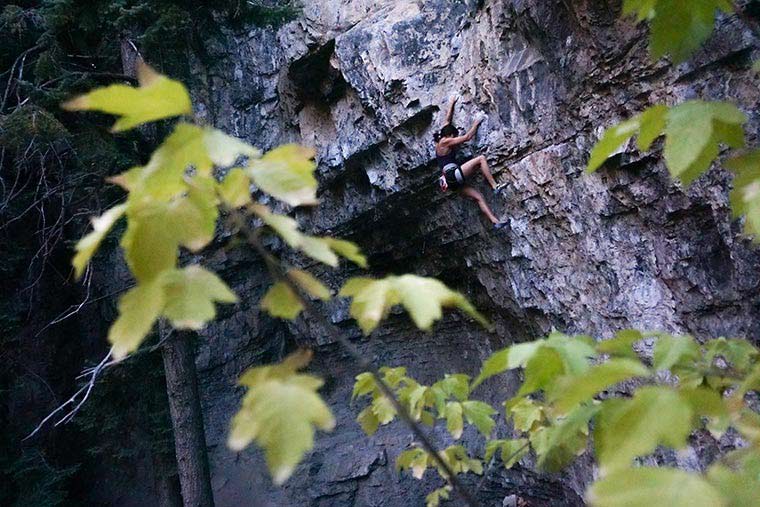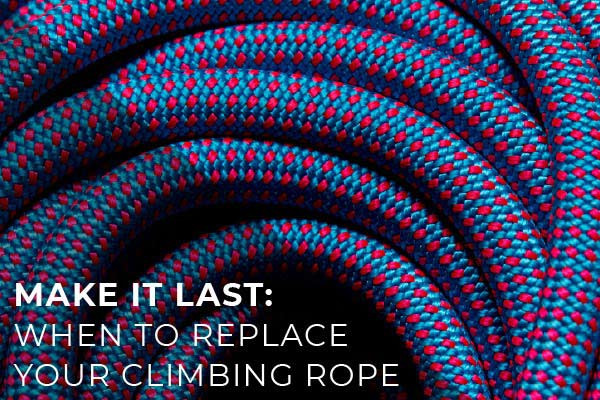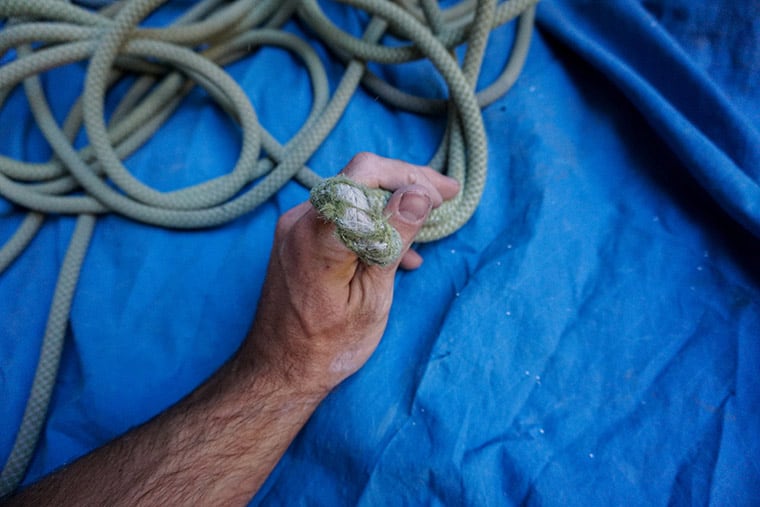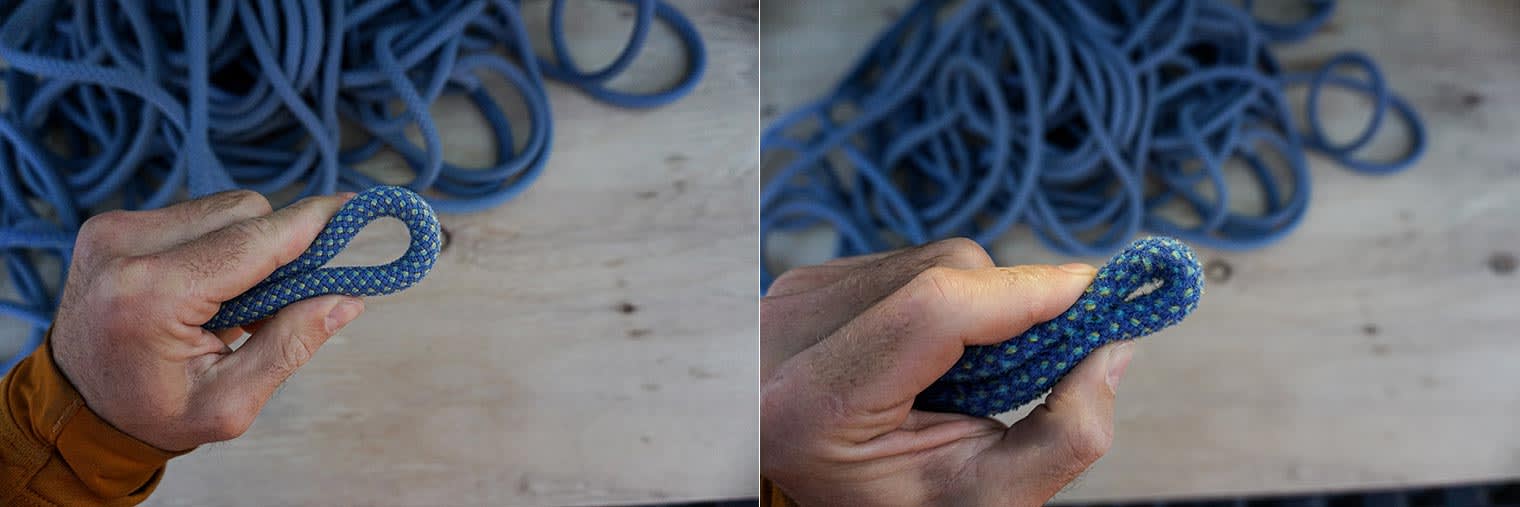Make It Last: When to Replace Your Climbing Rope
Posted by Dan Goodman on 28th Oct 2020
Make It Last is dedicated to getting the most out of your gear. This is our place to share knowledge acquired over years of abusing outdoor equipment, so you can learn from our experience and our mistakes. We want you to use your gear, patch it up until you can’t anymore, and enjoy it to the fullest. And when you finally need a new piece, we can help you with that too.
In climbing, there’s a technique for everything. Back-flags, heel-hooks, bat hangs, and yes, even taking care of your rope. Climbing ropes are expensive and you want to get the most out of your investment.
It’s not just a financial consideration either. You don’t want to find yourself 80 feet off the ground, thinking about how your rope has seen better days.
Inevitably, climbers are always wondering how far they can take a rope before it’s time to hang it up for good. This leads climbers to wonder things like:
- How do I inspect a rope?
- Can I trim the damaged ends off of a rope?
- When should I retire a rope?
- What can I do with my rope once it’s retired?
For this article, we’ll bypass the usual rigamarole of describing how you should use a rope tarp, store your rope(s) in a dry place, and avoid stepping on your rope. Instead, we want to highlight what to do when you think your rope may be damaged, and how to proceed when you find a damaged section of rope.
A clear core shot showing that this climbing rope is no longer suitable for use.
Rope Inspection
Learning how to inspect your rope is vital for any climber. Get in the habit of doing this every session before getting on the wall, starting the day you remove it from the packaging. It may sound excessive if you’re not already in the habit, but you’ll find that it only takes a minute to give a quick once over while flaking out your rope, before tying in.
Start at one end of the rope and flake it slowly onto the ground by your side or into a butterfly coil, looking and feeling for any abnormalities. With use, any climbing rope will show signs of wear including minor fuzzies on the sheath, but that’s not what we’re after. You’re looking for major nicks, cuts, and damage to the rope’s sheath, or soft spots in the core.
Soft Spots
Of these, the trickiest to identify are soft spots, which indicate damage to the core. You’ll generally find these within the first 15 feet of the end of a rope, as that’s the area that takes the brunt of the impact from repeated falls.
To identify a soft or flat spot in your rope, pinch a small bight of rope in between your index finger and thumb around the area in question. Next, take a similar sized bight from near the center of the rope and compare the two.
The teardrop shape on the left photo shows that the core is still in good condition, while the right photo identifies a soft spot in the core.
If the bight near the end of the rope is substantially softer and/or leaves little to no gap when pinched, it may be compromised. Over time, and by doing this regularly, you’ll get a feel for your rope and will learn how wear and tear affect it.
Let’s assume that you perform this test and don’t like what you find. What’s next?
Damaged Ropes
If the damaged section in question happens to be near the end of the rope, you can safely trim it off and continue to use the rope, provided that the rest of the rope is undamaged.
- Start by identifying where you want to cut the rope, typically a few inches past the last point of noticeable damage.
- Wrap a piece of tape around the rope where you plan to cut.
- Using a sharp knife or surgical scissors, cut off the end as cleanly as possible. Be cognizant of sharp objects around the rest of your rope, and move slowly to avoid making a mistake.
- Using a lighter, shrink down and mold any leftover nylon fibers.

Taping, cutting, and burning your rope to create a new end is something that can be done easily at the crag.
If only one end is damaged, you do not need to remove an equivalent amount of rope from the other side. Some climbers choose to do so for ropes with a mid-point marker to ensure that they have an accurate middle mark in the future.
It’s also important to remember that your rope is now shorter than it was before. You may find it useful to measure the length of the section you removed and note the new rope length by writing it onto a piece of tape and attaching it to the end of the rope.
If the damaged section is closer to the middle of the rope, you can still remove it, but you’ll be left with two, likely unequal, rope lengths that may not be long enough for future use, except maybe in the gym.
Climbing Rope Retirement
Retiring your rope is touchy, and is a decision you’ll have to make yourself, but there are still a few guidelines we recommend.
Manufacturers generally say that if your rope is ten years old or more, no matter how much it’s been used, you should retire it. This is due to the natural degradation of nylon over time.
Otherwise, look to indicators of wear to guide when you should retire a rope. For instance, if you find substantial damage (soft spots, core shots, or other damage to the sheath) or if your rope is damaged by rockfall or some other extenuating circumstance, it’s time for a replacement.
A rope that’s clearly ready to be retired and turned into something useful for non-climbing related activities.
Similarly, if your rope somehow encounters your car battery, battery acid, or any other corrosive chemical, you should retire it immediately. It doesn’t matter how new your rope is, how it looks, or how little use you’ve gotten out of it. Your life is worth spending $200 on a rope you can trust.
If all else fails, most manufacturers provide guidelines for rope retirement that fall somewhere within this framework:

What To Do With a Retired Rope?
Climbing rope, unlike most climbing gear, has plenty of other uses in its old age.
Utilitarians will love that it can be cut up and used to cinch down items to the top of the car while moving, or can be used as a makeshift tent guyline in a pinch.
If you feel a bit craftier, you can weave old ropes into chairs, hammocks, rugs, or even beer coozies, for the post send celebration.
At the very least, cut off a strand and use it for a dog leash.

Weaving your rope into a rug is one of many things you can do with a retired climbing rope.
You can also recycle it. Several climbing companies, including Sterling and Millet will accept ropes for their nylon recycling program. This means you won’t end up causing drama with your roommates for hoarding rope rugs, and you can still feel good about getting them out of the house.

Conclusion
Your climbing rope is a vital piece of equipment that should be well maintained and taken care of. By regularly inspecting your rope, starting with the day you pull it out of the packaging, you’ll begin to learn what a rope looks like throughout its life cycle. With that knowledge, you can start to make informed decisions about whether or not to continue to use that rope in the future.
This article is not meant to be a replacement for proper training or meant to teach you everything you need to know about ropes. If you have questions about the efficacy of a rope, ask a professional or another expert before continuing to climb on it.
About Campman
Campman is an outdoor retail store located in Salt Lake City, Utah, that specializes in gear and equipment for camping, skiing, backpacking, climbing, and everything in between. We understand that the difference between a bad memory and the adventure of a lifetime can come down to the gear you take with you when you head outdoors, and we want our customers to have the best experiences possible. When it comes to getting outside, we get it, and we’ll get you the gear you need to get there.
Questions? Feel free to contact us by phone at (801) 999-8117 or by email at sales@campman.com
Share on:




